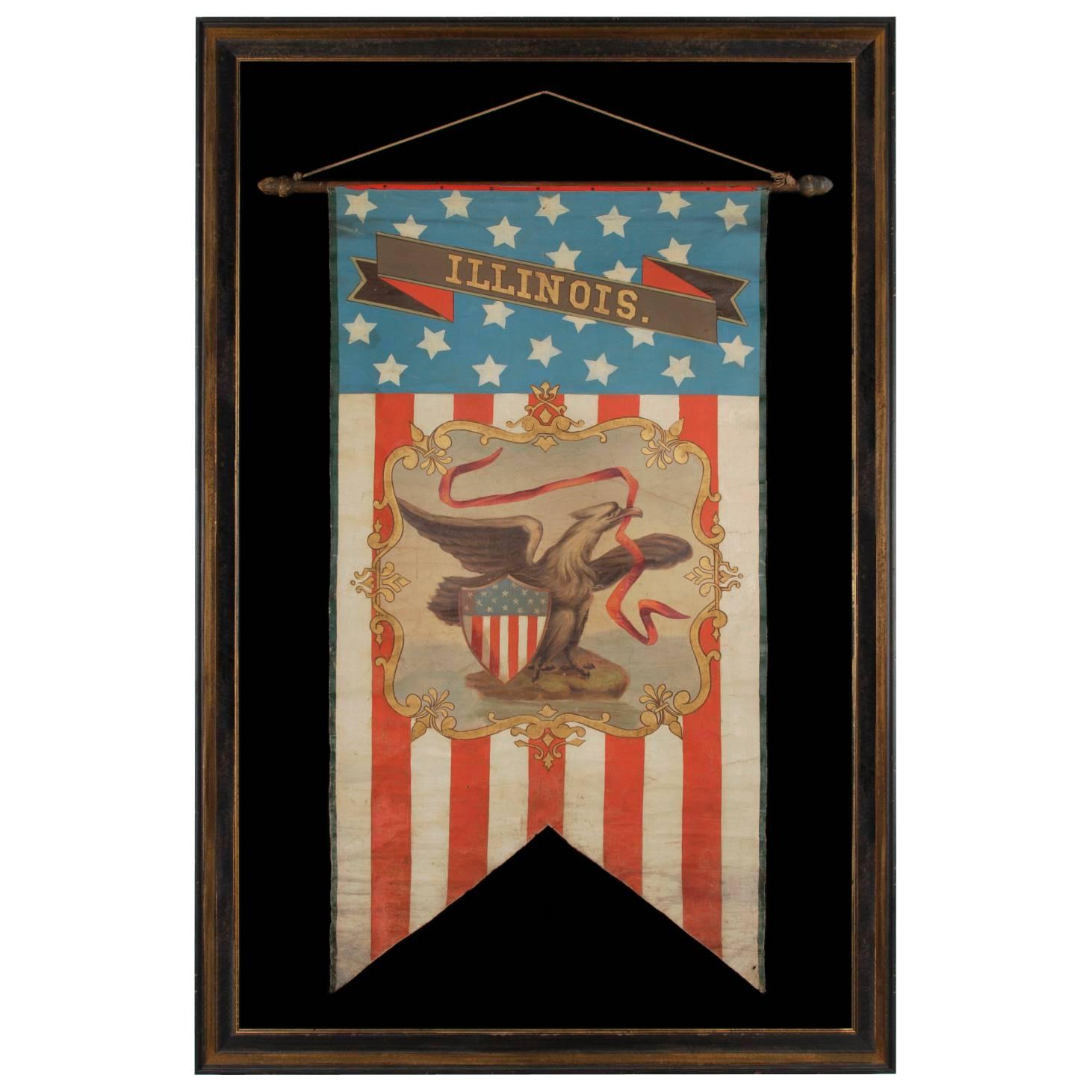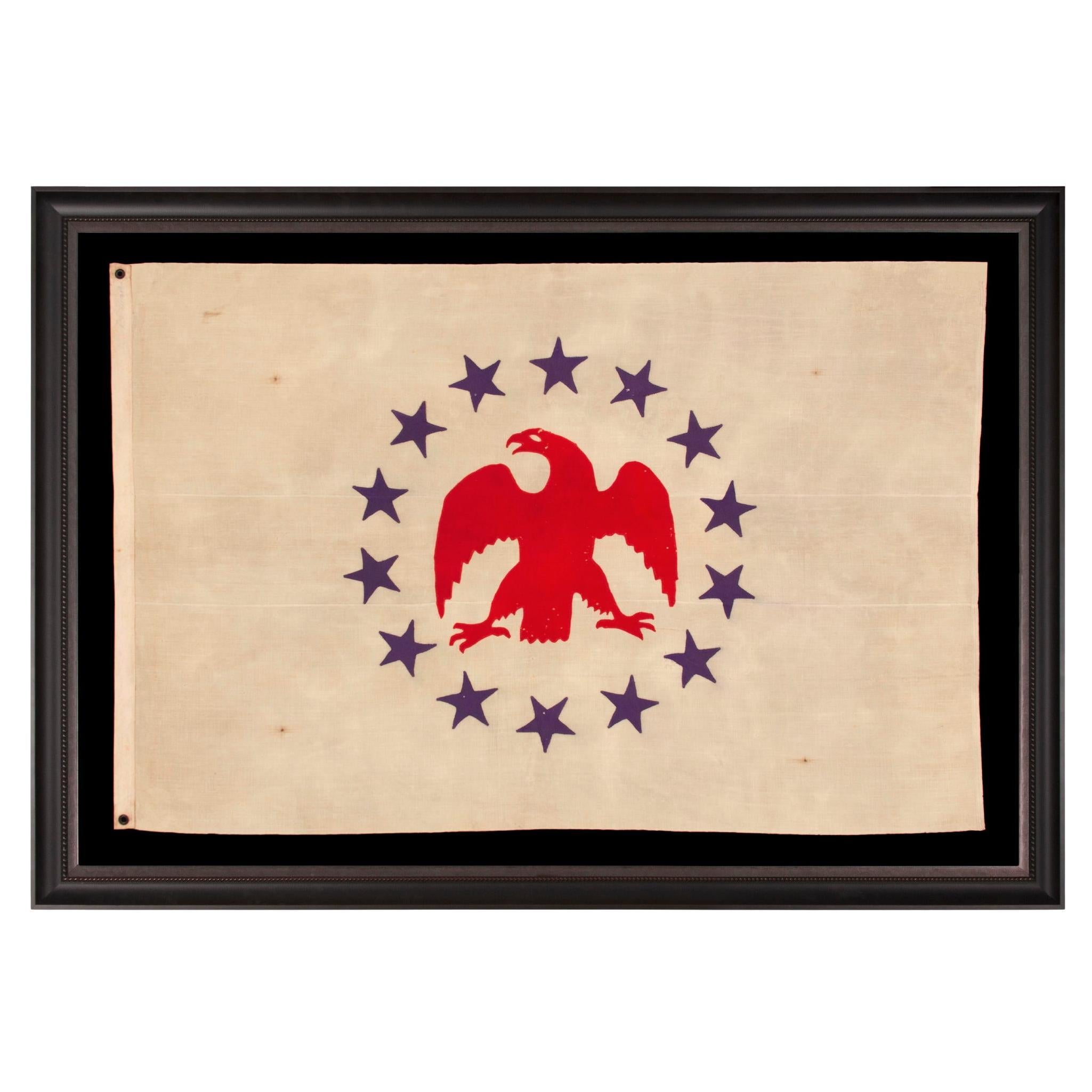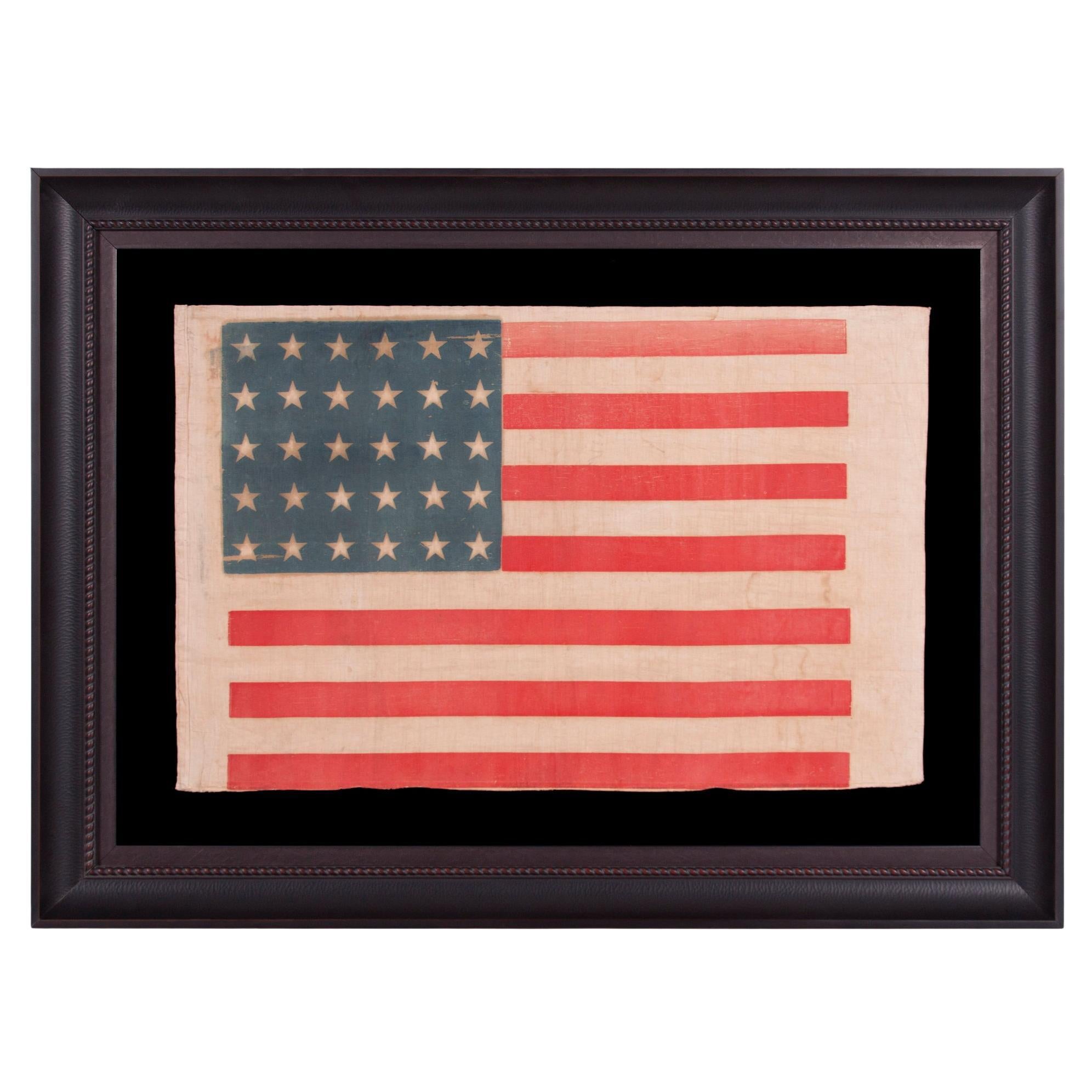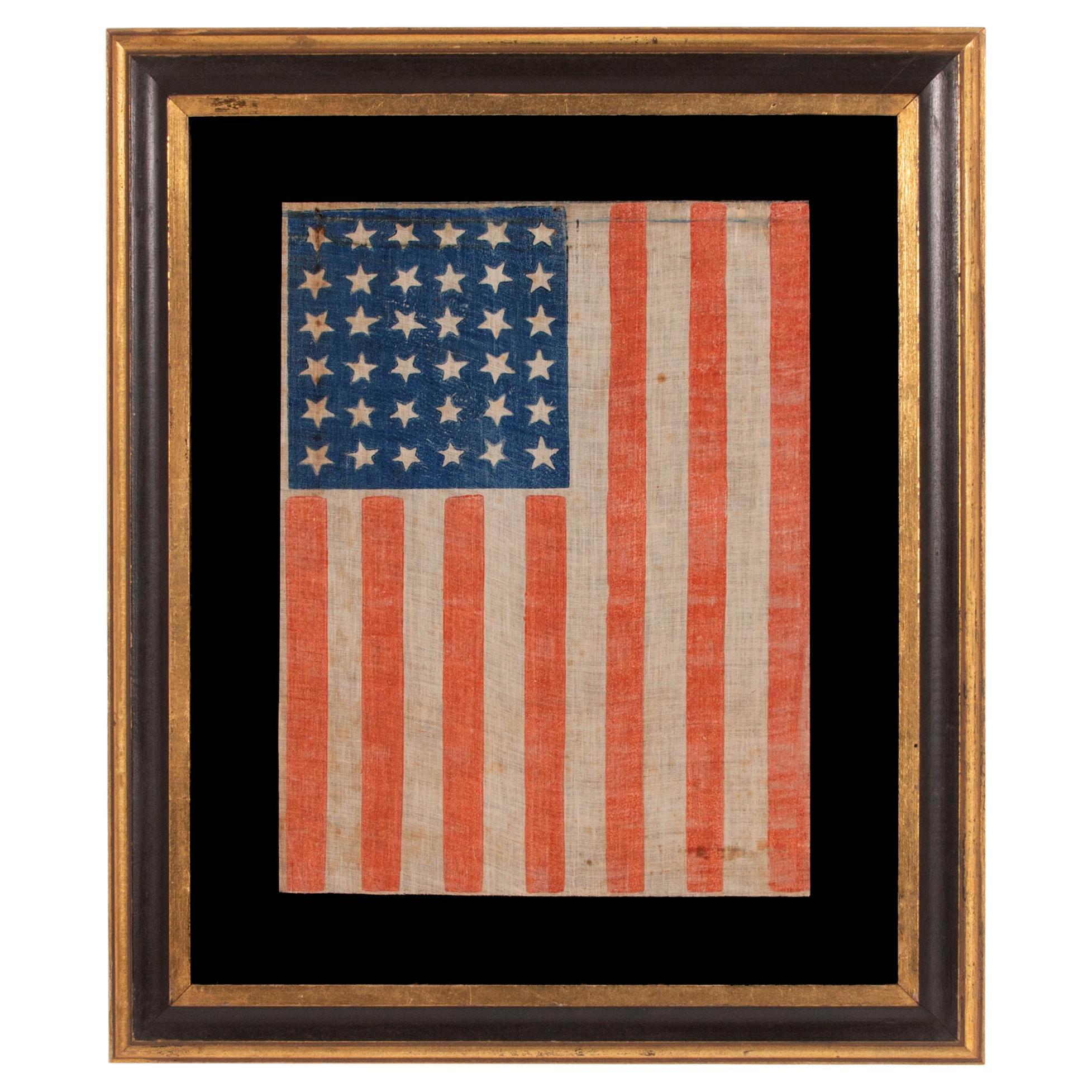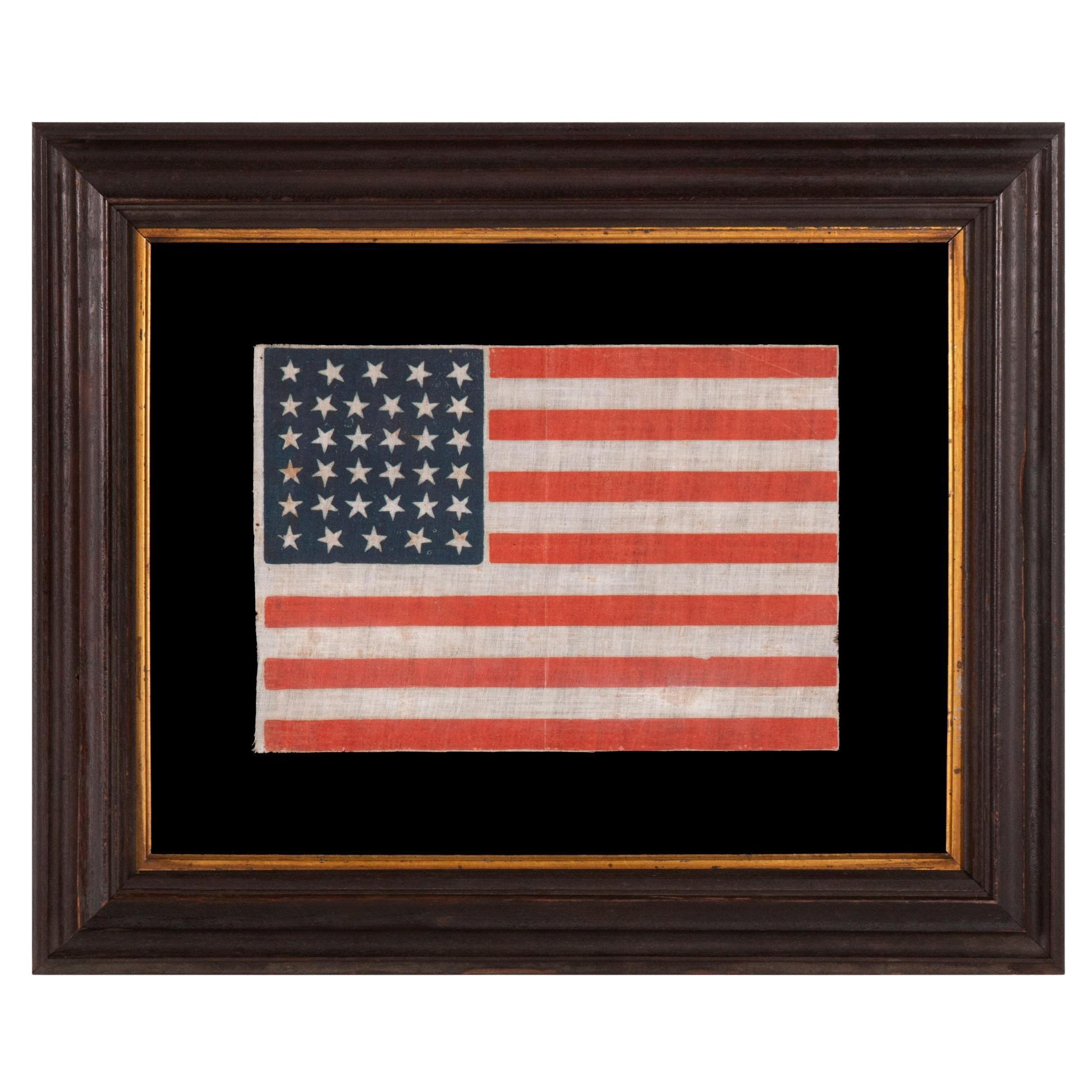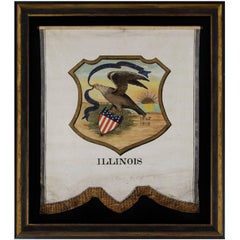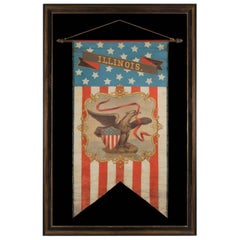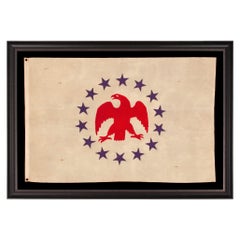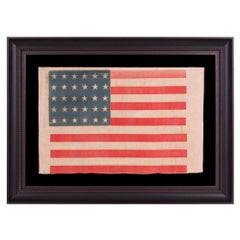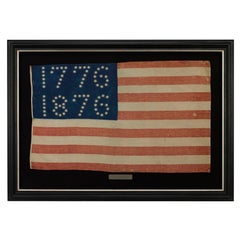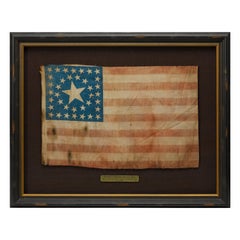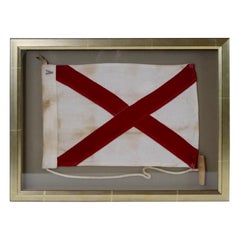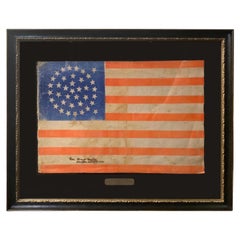Items Similar to Hand-Pained Banner with the Seal of the State of Mississippi, circa 1872
Want more images or videos?
Request additional images or videos from the seller
1 of 11
Hand-Pained Banner with the Seal of the State of Mississippi, circa 1872
Price Upon Request
Price Upon Request
Price Upon Request
Price Upon Request
Price Upon Request
Price Upon Request
Price Upon Request
Price Upon Request
Price Upon Request
Price Upon Request
Shipping
Retrieving quote...The 1stDibs Promise:
Authenticity Guarantee,
Money-Back Guarantee,
24-Hour Cancellation
About the Item
Unique, hand-painted banner with the seal of the state of mississippi, likely having represented delegates from that state at the 1872 republican or democrat national convention [similar examples identified at both]
Banner with the seal of the State of Mississippi, hand-painted on canvas, with a polychromatic surface, pleasant craquelure, patina, and wear. Retaining its original staff, the banner features a white-painted ground, set between bluish-grey-painted borders to the left and right, with black pinstriping. The lower edge is attractively scalloped, and paint-decorated, to look as if it were fringed with a border of braided, metallic rope. There are heavy metal grommets in the lower two corners, behind which are large, triangular, cotton patches. These are original to the construction. The abbreviate “MISS” is crudely hand-painted on the reverse, in black, at the lowest point. This would have allowed for quick identification among other banners, without having to unroll them.
America secured claim to much of the territory east of the Mississippi River, from Spain, by way of the 1795 Treaty of San Lorenzo (a.k.a., Pinckney’s Treaty). In 1798, some of the lower portion of present-day Mississippi and Alabama became the Mississippi Territory. Almost immediately, even before its formal incorporation, on April 7th, 1798, the Mississippi Territory’s governing body produced a seal, the design of which took the same basic form as the Great Seal of the United States. Adopted on January 19th, 1798, the device featured a spread winged eagle, with a federal shield upon its breast, holding the usual olive branch in its proper right talon, and arrows in its left. The head of the eagle was turned so that its gaze faced the olive branch, as a symbol of peace. Held in its beak was the usual, billowing streamer, with the Latin motto “E Pluribus Unum” (Out of Many, One), above and around which were 13 randomly placed stars, set beneath an arch of clouds. Beyond this, protruding as from behind the entire image, and fanning out in all directions, were rays of sunlight.
The Mississippi Territory was initially comprised of a swath of land that spanned about 1/3 of the present day state, as well as that of Alabama. The line began about half way down their combined expanse, running horizontally across the region. The State of Georgia claimed rights to this area, but could not defend a position of ownership. In 1804, the northernmost half of the two future states was annexed to the Mississippi Territory, with opposing claims made that this was merely part of the 1803 Louisiana Purchase. Then, in 1812, the remaining, southern edge, along the Gulf of Mexico, was finally included. So by that year, the Mississippi Territory encompassed almost all of present-day Alabama.
The Territory gained statehood on December 10th, 1817, and a new seal was adopted about a month later, on January 19th, 1818. This switched the position of the olive branch and arrows, while simultaneously directing the latter inward and down, instead of upward and away. Absent now were the stars, streamer, sun, and clouds, so that only the eagle, arrows, and olive branches remained. Around the perimeter, a descriptive title was added that read: “The Great Seal of the State of Mississippi.”
Just over a year-to-the-day from Mississippi Statehood, the eastern half of the former territory became Alabama, ushered in as an independent state. The Mississippi seal remained constant, however, until 1894, when the state’s Latin motto, “Virtute et Armis” (By Valor and Arms), was added on a banner below, to create the official Mississippi Coat of Arms. This remained in use until 2014, when “In God We Trust” was added to the seal itself, along the lower portion of the circumference.
Painted during the second half of the 19th century, the device illustrated on this particular Mississippi banner, deviates from the official, 1818 version. The eagle, perched above the clouds, on a blue sky, turns its head its proper right, but the points of the arrows, now outward and upward, fall within the general line of its gaze.
Note how the federal shield is purposefully omitted. Made sometime just following the close of the Civil War (1861-1865), most likely during the period of Reconstruction of the South (1865-1876), the absence of such a keen Union symbol is of little surprise. The inclusion of three arrows may likewise be purposeful. Though the meaning is less clear, symbolism of this sort abounds in flags and other patriotic devices of this era.
This banner was once part of a much larger group—a fact evidenced by surviving examples that illustrate other states. In addition to Mississippi, examples of this particular group survive that represent Ohio, Illinois, Pennsylvania, Virginia, and New York. Four of these six I have owned. If I knew nothing else about them, save my examination of the construction and painted surface, I would date them circa 1870-1890. But additional information can be gleaned from the state devices they display, which changed over time.
The Ohio banner, for example, includes a combination of elements present in both the 1866 and 1868 versions. The Illinois banner reflects imagery proposed by Illinois Secretary of State Sharon Tyndale, in 1867, yet never accepted. Because these features were actually rejected, when a new design was approved just a year later, in 1868, one may surmise a very narrow window of possible production.
Knowing that banners in this basic style and scale were displayed to mark the location of state delegates at political conventions, research was undertaken to identify similar forms in 19th century photographs and illustrations. The most likely date seemed to be 1868, but I was already very familiar with the illustration of Tammany Hall in that year, in Manhattan, as decorated for the New York Democrat National Convention, and I knew that this precise style was not illustrated. I was also aware of another variety that may have been used elsewhere in the Democrat venue that year, but employed a swallowtail design and were likewise not a match.
An image of the 1868 Republican counterpart, held in Chicago at Crosby's Opera House, was much more difficult to locate, but when I tracked that down, I discovered it surprising void of the usual buntings and flags.
Turning my focus to engravings from other conventions, I examined everything I could find between 1856 and 1900. The most similar banners I found were displayed in just two halls, both in 1872, just one election year later than suspected. This was the race when incumbent Republican President Ulysses S. Grant, faced off against former Republican power broker and newspaper publisher, Horace Greeley, who ran on an independent ticket, eventually endorsed by the Democratic Party establishment.
The 1872 Republican convention was held in Pennsylvania at the Philadelphia Academy of Music, while the opposing, Democrat convention was held in Baltimore at Ford's Opera House. Detailed illustrations of both survive and clearly display what appear to be white banners, of a similar scale, featuring state crests, lining the balconies at both venues.
Given that the surviving banners of similar form have come from all different sources, it seems likely that they were taken home by delegates following the event. The Mississippi example turned up in Tennessee. The two states border one-another in their northeast / southwest corners. Because banners of this type are extremely rare, and because very little in the way of 19th century flags or patriotic textiles exist that in any way relate to Mississippi, this is an extraordinary object and a remarkable relic of the state.
Mounting: The banner was mounted and framed within our own conservation department, which is led by expert staff. We take great care in the mounting and presentation of flags and related textiles, and have preserved thousands of examples.
The background is 100% cotton twill, black in color, that has been washed and treated for colorfastness. The mount was placed in a black-painted, hand-gilded and distressed Italian molding. A shadowbox was created to accommodate the staff. The glazing is U.V. protective acrylic (Plexiglas). Feel free to contact us for more details.
Condition: There is modest soiling throughout, accompanied by moderate areas of the same, especially in the upper right-hand quadrant of both the device and the white field. There is some creasing, craquelure, and associated paint loss, the latter of which is present in the lower register, from the word “Mississippi” down to the painted fringe. There is a 3-inch, J-shaped tear below the lettering, in the white region, and there is a lateral tear, of similar size, below it, in the painted border, where other, smaller tears are also present, both adjacent and nearby. Several, small, rectangular patches were added. The extreme rarity of state flags and banners, especially from a state like Mississippi, for which almost no 19th century material exists, well-warrants its state of preservation.
- Dimensions:Height: 68 in (172.72 cm)Width: 58 in (147.32 cm)Depth: 4 in (10.16 cm)
- Materials and Techniques:
- Place of Origin:
- Period:
- Date of Manufacture:1872
- Condition:See Item Description.
- Seller Location:York County, PA
- Reference Number:Seller: pat-6911stDibs: LU849733807272
About the Seller
5.0
Recognized Seller
These prestigious sellers are industry leaders and represent the highest echelon for item quality and design.
Established in 1991
1stDibs seller since 2008
70 sales on 1stDibs
Typical response time: 1 to 2 days
- ShippingRetrieving quote...Shipping from: York County, PA
- Return Policy
Authenticity Guarantee
In the unlikely event there’s an issue with an item’s authenticity, contact us within 1 year for a full refund. DetailsMoney-Back Guarantee
If your item is not as described, is damaged in transit, or does not arrive, contact us within 7 days for a full refund. Details24-Hour Cancellation
You have a 24-hour grace period in which to reconsider your purchase, with no questions asked.Vetted Professional Sellers
Our world-class sellers must adhere to strict standards for service and quality, maintaining the integrity of our listings.Price-Match Guarantee
If you find that a seller listed the same item for a lower price elsewhere, we’ll match it.Trusted Global Delivery
Our best-in-class carrier network provides specialized shipping options worldwide, including custom delivery.More From This Seller
View AllHand-Painted 19th Century Banner with the 1867 Proposed Seal of Illinois
Located in York County, PA
HAND-PAINTED 19TH CENTURY BANNER WITH AN 1867 VERSION OF THE SEAL OF THE STATE OF ILLINOIS, PROPOSED IN THAT YEAR BY THE SECRETARY OF STATE, BUT IN A VARIATION NEVER FORMALLY ADOPTED
Banner with the Illinois State Seal, in a rare variation of the design, never adopted. In 1867 Illinois Secretary of State Sharon Tyndale proposed that the phrases in the state motto be reversed. In the wake of the Civil War, (which ended in 1865,) Tyndale suggested that the verbiage be changed from "State Sovereignty--National Union" to "National Union--State Sovereignty,” which made sense given the recent secession of the Southern States, which placed their own interests first. Illinois' own Abraham Lincoln had worked hard to preserve national interests, echoed here in the altering of the language. Though Tyndale’s suggestion was rejected, he was nonetheless charged with creating a new design, which he did and was soon adopted. This displayed the dates of "1818," when Illinois became a state, and "1868," when the seal was officially changed. Interestingly enough, Tyndale did manage to send a message in the new version by turning the word “sovereignty” upside-down , with the surmised explanation that this fit accordingly with the orientation / position of the streamer.
The banner is beautifully hand-painted on muslin and retains its original staff. The shape is beautifully scalloped at the bottom edge, which is painted to look as if there is an applied fringe. Most of the elements are congruent with the 1868 version, but there are various differences. Set within a shield-shaped medallion—usually circular—is the expected eagle in a side view, spread wing pose with beak uplifted. The eagle is supposed to be perched upon a rock with one talon, while gripping a Federal shield in the other. Here there is no rock and both talons grip the shield, which displays 13 stars. Note the date of "1867" and Tyndale's preferred order of the wording on the billowing ribbon in the eagle's beak. The foreground of the official design is all grass. Here there are olive branches—a peacetime reference appropriate for a country recovering from war—on a grassy area, set upon a sandy shore before Lake Michigan, with a rising sun on the horizon.
Mounting: The banner was mounted and framed within our own conservation department, which is led by masters degree trained staff. We take great care in the mounting and presentation of flags and have preserved thousands of examples; more than anyone worldwide.
The background is 100% cotton twill, black in color. The mount was placed in a black-painted, hand-gilded and distressed Italian molding. A shadowbox was created to accommodate the staff. The glazing is U.V. protective plexiglass. Feel free to contact us for more details.
Banner - 49" x 56.5"
Frame - 67.75" x 59.25"
About Jeff R. Bridgman Antiques, Inc.:
As an advisor to top museums and collectors alike, Jeff Bridgman is the world's leading expert and source for antique American flags and political textiles...
Category
Antique 1860s American Political and Patriotic Memorabilia
Materials
Cotton
Price Upon Request
Hand-Painted Patriotic Banner With The Seal of the State of Illinois
Located in York County, PA
HAND-PAINTED PATRIOTIC BANNER WITH THE SEAL OF THE STATE OF ILLINOIS AND GREAT FOLK QUALITIES PROBABLY MADE FOR THE 1868 DEMOCRAT NATIONAL CONVENTION...
Category
Antique 1860s North American Political and Patriotic Memorabilia
Materials
Canvas
Price Upon Request
Hand-Sewn Flag w/ Eagle & 14 Stars, Made by Sarah McFadden in NYC, ca 1852-1860
Located in York County, PA
ENTIRELY HAND-SEWN FLAG MADE BY SARAH McFADDEN, “THE BETSY ROSS OF NEW YORK,” FOR THE HUDSON RIVER STEAMSHIP “DELAWARE,” LAUNCHED IN 1852, WHICH SAW A REMARKABLE HISTORY; CONSCRIPTE...
Category
Antique Mid-19th Century American Political and Patriotic Memorabilia
Materials
Cotton
30 Star Antique American Parade Flag, Wisconsin Statehood, ca 1848-1850
Located in York County, PA
ANTIQUE AMERICAN PARADE FLAG WITH 30 STARS, THE ONLY KNOWN EXAMPLE IN THIS SIMPLE BUT EXTRAORDINARY STYLE, PRE-CIVIL WAR, OFFICIAL FOR JUST TWO YEARS, REFLECTS THE ADDITION OF WISCON...
Category
Antique Mid-19th Century American Political and Patriotic Memorabilia
Materials
Cotton
Price Upon Request
36 Star Antique Parade Flag, Vertical Position, Nevada Statehood, ca 1861-1867
Located in York County, PA
36 STAR ANTIQUE AMERICAN PARADE FLAG, WITH STARS THAT ALTERNATE IN THEIR VERTICAL POSITION FROM COLUMN TO COLUMN AND ROW-TO-ROW, PRINTED ON AN ESPECIALLY INTERESTING LENGTH OF COARSE...
Category
Antique Late 19th Century American Political and Patriotic Memorabilia
Materials
Cotton
34 Star Antique American Parade Flag, Kansas Statehood, ca 1861-1863
Located in York County, PA
34 STARS, WITH SCATTERED POSITIONING, ON AN ANTIQUE AMERICAN PARADE FLAG MADE DURING THE OPENING TWO YEARS OF THE CIVIL WAR, 1861-63, KANSAS STATEHOOD
34 star American national flag...
Category
Antique 1860s American Political and Patriotic Memorabilia
Materials
Cotton
Price Upon Request
You May Also Like
Centennial Celebration "1776-1876" American Flag Banner
Located in Colorado Springs, CO
Presented is a rare Centennial patriotic flag banner, dating to 1876. The flag’s brilliant blue canton is spectacular, with 81 five-pointed, rayed stars, arranged to read “1776” and “1876.” The flag’s design is completed with thirteen alternating red and white stripes. The flag is a three-piece, treadle-sewn sewn construction, printed on a thin wool and cotton blend. Along the edge, there is a narrow, treadle-sewn sleeve made of cotton tape.
In the lead up to the nation’s Centennial in 1876, flag makers and individuals looked to the past for designs to produce as part of the country’s many celebrations. Popular interpretation of the stars and stripes undoubtedly reached its climax of variety and originality at the time of our Nation’s first Centennial. Since no design restrictions were placed on flagmaker’s imaginations and no strict distinctions were drawn between official and unofficial star counts, it is no surprise that, on the occasion of the Centennial, creativity in flag design was not the exception, but the rule.
The cantons from this period presented an array of geometric abstractions. Great star patterns, referred to as the “starry flower of Liberty” by Oliver Wendell Holmes, that were popular from 1818 and on, resurfaced in Centennial flags...
Category
Antique 1870s American Political and Patriotic Memorabilia
Materials
Wool, Cotton
38-Star Antique American Flag with Unique Canton, circa 1876-1890
Located in Colorado Springs, CO
This is a striking 38-star American flag. The flag dates to 1876-1890, when Colorado (represented by the large star in the center of the flag’s canton) joined the Union as the 38th s...
Category
Antique Late 19th Century American Political and Patriotic Memorabilia
Materials
Muslin
Framed Maritime Signal Flag of Letter V
Located in Norwell, MA
Framed marine pennant representing the letter V set into a shadow box frame with rope and wood toggle. Weight is 5 pounds.
Category
Vintage 1950s Nautical Objects
Materials
Cotton
38-Star American Parade Flag, Flown at a Reception for President Grant, 1880
Located in Colorado Springs, CO
This is a beautifully colored 38-star American parade flag, flown at a public reception for Ulysses S. Grant in October of 1880. This printed flag features a rare, triple medallion s...
Category
Antique 1880s American Political and Patriotic Memorabilia
Materials
Cotton
Original Antique Map of the American State of Mississippi, 1903
Located in St Annes, Lancashire
Antique map of Mississippi
Published By A & C Black. 1903
Original colour
Good condition
Unframed.
Free shipping
Category
Antique Early 1900s English Maps
Materials
Paper
31-Star Printed American Flag, Celebrating California Statehood, Circa 1850
Located in Colorado Springs, CO
This is a rare 31-star medallion printed American flag, celebrating the addition of California to the Union. The flag is printed on silk and has a spectacular “Great Star” canton pat...
Category
Antique 1850s American Political and Patriotic Memorabilia
Materials
Silk
More Ways To Browse
Antique Cotton Scale
Antique Hand Painted Photographs
Mississippi Furniture
Mount Of Olives
Hand Fans Italy
Mississippi Antique
Antique Hand Painted Fan
Hand Painted Banner
Black Southern Folk Art
Antique Mississippi Furniture
Small American Flag
Great Seal Of The United States
Georgian Seal
Eagle Shield
War Of 1812
Virginia House Furniture
Painted Baltimore Furniture
Eagle And Flag

